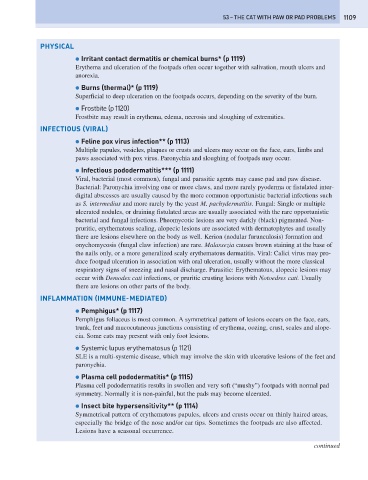Page 1117 - Problem-Based Feline Medicine
P. 1117
53 – THE CAT WITH PAW OR PAD PROBLEMS 1109
PHYSICAL
● Irritant contact dermatitis or chemical burns* (p 1119)
Erythema and ulceration of the footpads often occur together with salivation, mouth ulcers and
anorexia.
● Burns (thermal)* (p 1119)
Superficial to deep ulceration on the footpads occurs, depending on the severity of the burn.
● Frostbite (p 1120)
Frostbite may result in erythema, edema, necrosis and sloughing of extremities.
INFECTIOUS (VIRAL)
● Feline pox virus infection** (p 1113)
Multiple papules, vesicles, plaques or crusts and ulcers may occur on the face, ears, limbs and
paws associated with pox virus. Paronychia and sloughing of footpads may occur.
● Infectious pododermatitis*** (p 1111)
Viral, bacterial (most common), fungal and parasitic agents may cause pad and paw disease.
Bacterial: Paronychia involving one or more claws, and more rarely pyoderma or fistulated inter-
digital abscesses are usually caused by the more common opportunistic bacterial infections such
as S. intermedius and more rarely by the yeast M. pachydermatitis. Fungal: Single or multiple
ulcerated nodules, or draining fistulated areas are usually associated with the rare opportunistic
bacterial and fungal infections. Pheomycotic lesions are very darkly (black) pigmented. Non-
pruritic, erythematous scaling, alopecic lesions are associated with dermatophytes and usually
there are lesions elsewhere on the body as well. Kerion (nodular furunculosis) formation and
onychomycosis (fungal claw infection) are rare. Malassezia causes brown staining at the base of
the nails only, or a more generalized scaly erythematous dermatitis. Viral: Calici virus may pro-
duce footpad ulceration in association with oral ulceration, usually without the more classical
respiratory signs of sneezing and nasal discharge. Parasitic: Erythematous, alopecic lesions may
occur with Demodex cati infections, or pruritic crusting lesions with Notoedres cati. Usually
there are lesions on other parts of the body.
INFLAMMATION (IMMUNE-MEDIATED)
● Pemphigus* (p 1117)
Pemphigus foliaceus is most common. A symmetrical pattern of lesions occurs on the face, ears,
trunk, feet and mucocutaneous junctions consisting of erythema, oozing, crust, scales and alope-
cia. Some cats may present with only foot lesions.
● Systemic lupus erythematosus (p 1121)
SLE is a multi-systemic disease, which may involve the skin with ulcerative lesions of the feet and
paronychia.
● Plasma cell pododermatitis* (p 1115)
Plasma cell pododermatitis results in swollen and very soft (“mushy”) footpads with normal pad
symmetry. Normally it is non-painful, but the pads may become ulcerated.
● Insect bite hypersensitivity** (p 1114)
Symmetrical pattern of erythematous papules, ulcers and crusts occur on thinly haired areas,
especially the bridge of the nose and/or ear tips. Sometimes the footpads are also affected.
Lesions have a seasonal occurrence.
continued

